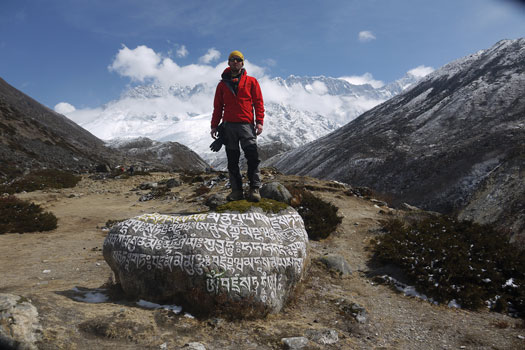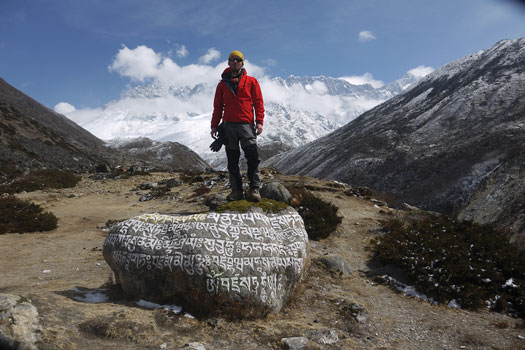Working life: The GP with altitude

Profile Dr Will Duffin

Roles Locum GP in Bristol; Urgent Care GP for Brisdoc out-of-hours GP service; Teaching Associate for the University of Bristol and Education Lead for World Extreme Medicine
Hours worked per week Typically four clinical sessions, two sessions of education and one session of preparing the next trip
Week 1
Monday
On the first day of this month’s adventure I’m with Everest summiteer Jo Bradshaw, taking a group of trekkers to Everest Base Camp in Nepal. It’s a spectacular 12-day climb up the Khumbu Valley.
We fly from Kathmandu to our starting point in Lukla, a small town at 2,840m on the slopes of the Himalayas. The tiny prop-engine plane lands on an impossibly steep and short runway, to rapturous applause from its relieved passengers.
Wednesday,
We snake through the valley towards Namche Bazaar (3,440m) across a series of high footbridges, which appear gossamer thin against the gargantuan landscape. That night, I diagnose one trekker with mild acute mountain sickness, advise her to rest and start acetazolamide 250mg. The whole group struggles to sleep, a common problem at altitude due to ‘periodic breathing’ – irregular gasping as your respiratory centre adjusts to the thinner air. We stay two nights, to acclimatise and ensure everyone is well enough to continue.
Being a locum GP gives me flexibility to take opportunities like this; I can schedule the ‘fun stuff’ around actually paying the mortgage. My first trip was a 2012 climb of Kilimanjaro at short notice after another medic dropped out. It was a baptism of fire but a week-long expedition medic course and a stint working in ED in Australia helped prepare me. That trip has opened the door to many more adventures.
Friday
We’re getting distant but tantalising glimpses of Everest through the forest canopy. From the summit, an icy finger of spindrift pierces the cloudless sky. We reach Tengboche (3,890m), the site of a Buddhist monastery where summiteers pause for traditional candlelit blessings.
That evening I play football with the monks. I’m not fully acclimatised and after a few kicks my hands are locked onto my knees and I’m puffing like a steam engine. After dinner, some of the group report diarrhoea and abdominal cramps. I give ciprofloxacin to each, and reinforce the need for rigorous hygiene including a ‘buddy system’ at mealtimes to minimise further spread. On these trips, diarrhoeal illness can spread like wildfire.
Week 2
Tuesday
We hit a formidable weather front and have to form a tight peloton against blizzard conditions and battering wind, bending our frames into the slope. Seven hours later we reach the teahouse at Lobuche (4,910m). It feels like a bleak, godforsaken place. There is no wood to burn, so we keep warm around a furnace of yak dung. That night, one of the group, Daniel, is unable to stop throwing up. I grimace at the stench of vomit and the smoky fug of dung as I ease intramuscular prochlorperazine into his right buttock.
Wednesday
After a sleepless night, Daniel falters after a few hundred metres. I have to send him back down with a porter; the double whammy of altitude sickness and gastroenteritis has scuppered him. Daniel is a carer for his wife who has Parkinson’s disease. Getting to the foot of Everest was his dream so it’s devastating to leave him, but I have to prioritise both his and the group’s safety. Such dilemmas have helped make me a better clinician; being able to make the right decision in time- and resource-poor situations is a valuable skill.
We press on, and after negotiating treacherous cambers, we reach our destination: Base Camp (5,364m). We pose for photos and take in our achievement. Around us, coloured prayer flags catch the wind as it whistles through the Khumbu Icefall above. We return along the same route, now under a relentless sun. By the time we reach camp at Gorak Shep (5,140m), my head is thumping and I want to lie motionless in my sleeping bag. But I’m swept into action by a wave of illness among the group – administering analgesia, oral rehydration and more antiemetics.
Using my medical skills to help people achieve life goals is immensely satisfying. Whether it’s helping someone to climb a mountain, or managing their hip pain so they can play hide and seek with their grandchildren, the rewards drive me on.
Pulse October survey
Take our July 2025 survey to potentially win £1.000 worth of tokens

Visit Pulse Reference for details on 140 symptoms, including easily searchable symptoms and categories, offering you a free platform to check symptoms and receive potential diagnoses during consultations.










